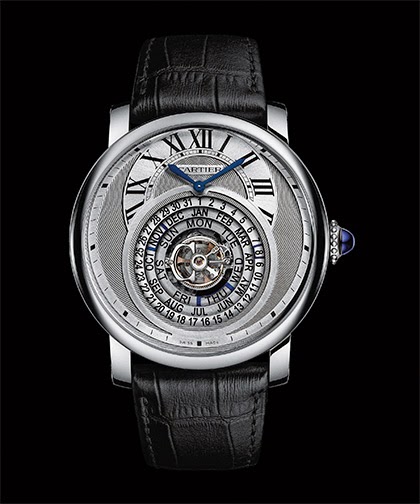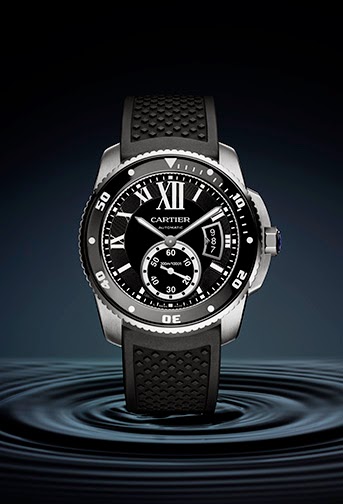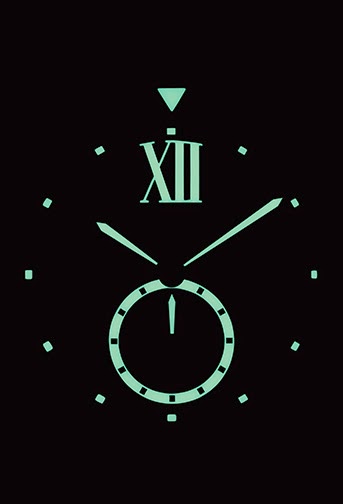Cartier: Fly Me to the Moon
Cartier shines with a rare combination of watchmaking artistry and aptitude that comes along once in a blue moon.
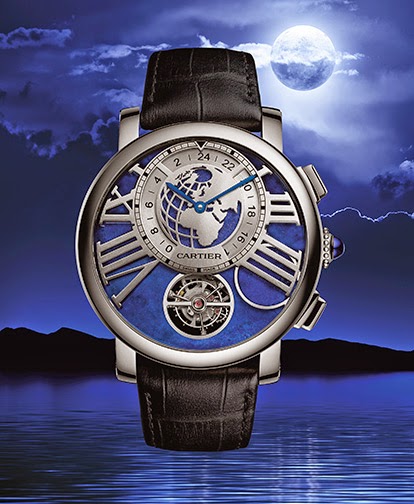
A spinning tourbillon plays the part of the moon in the watch’s exceptional on-demand lunar indicator.
The celebrated Parisian firm introduced one of the year’s most intriguing watches with the Rotonde de Cartier Earth and Moon. A marvel both inside and out, this limited edition (50 pieces) strikes an ideal balance between the brand’s technical expertise and its inimitable style.
Lapis lazuli provides a vibrant blue backdrop against the white gold that forms the layered dial. The Cartier aesthetic figures prominently throughout as exhibited by the Roman numerals stretching out around the chermin de fer (rail-track) minute scale that circles the stylized globe at the top of the dial. Nestled inside is a rotating 24-hour display for the watch’s GMT function, which is advanced by pushing the top button on the side of the 47mm platinum case.
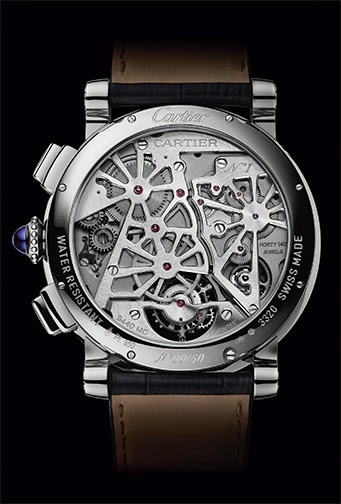
Caseback view of the Earth and Moon.
The other button controls the timepiece’s signature feature, an on-demand moon phase indicator. The brand’s new in-house movement tracks the lunar cycle internally, but only displays it when requested. That alone qualifies as an impressive horological feat. Cartier being Cartier, however, found a way to push the boundaries even further.
Fully in keeping with the brand’s unconventional take on this traditional astronomical complication, the rotating disc normally used to indicate the moon’s phases has been replaced by a spinning tourbillon. But how does it work? When the button is pushed, a lapis lazuli disc swings out from behind the numeral IIII and in front of the tourbillon to precisely recreate the shape of the illuminated moon in the night sky.
The view of the Cartier-made movement is equally impressive. The bridges are sculpted to form an intricate web that looks like stars twinkling around jewel bearings. That celestial aura is amplified by the extensive hand finishing, which produces a brilliant show when light bounces off the multitude of beveled edges.
Circular Time
At the same time that Cartier is taking the moon phase display to new heights, it’s also shaking up another classic complication with its groundbreaking reinterpretation of the perpetual calendar in the Rotonde de Cartier Astrocalendaire.
The display encompasses three concentric circles centered around a flying tourbillon cage. Each circle represents a different aspect of the calendar, starting with the day on the innermost ring, then the month and finally the date on the outside. Each tier features a blue window-shaped hand that highlights the pertinent calendar information. In addition to being distinctive aesthetically, the arrangement is more conducive to rapid readability than the relatively small sub-dials typically used for perpetual calendar watches.
Conceived and produced by Cartier, the movement that makes the Astrocalendaire’s concentric display possible also includes a number of performance enhancements designed to improve the experience of owning a perpetual calendar. Without a doubt, perpetual calendars are amazing machines that diligently calculate the irregular lengths of months and leap years. However, one must be careful when adjusting the calendar, because a correction made late in the evening can damage the caliber.
The Astrocalendaire’s movement avoids this troublesome issue by using a gear train-based calendar system instead of one that relies on springs and levers. This allows the watch to be adjusted at any time — forward or backward — using the crown instead of the tiny corrector buttons on most perpetuals. This particular feature will come as great relief to anyone who’s ever accidentally gone past the date when adjusting their perpetual. When that happens, the best way to get your watch back on track is to let it wind down so the actual date can catch up to the date on your watch.
Presented in a 45mm platinum case, the Rotonde de Cartier Astrocalendaire will be offered in a limited series of 100 numbered pieces.
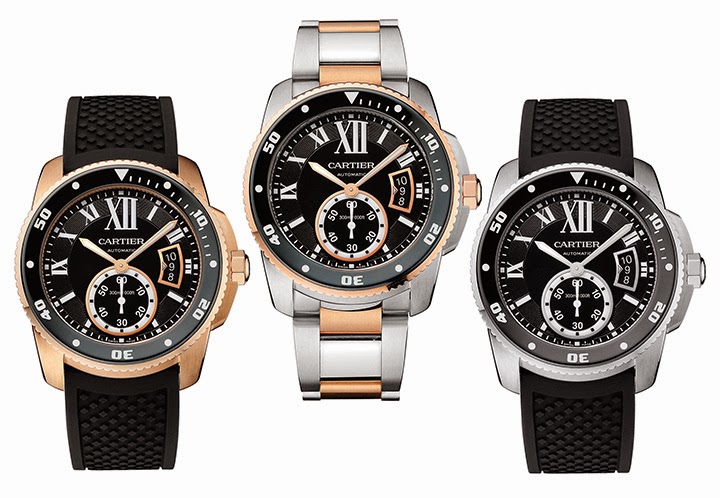
Three versions of Cartier’s first-ever dive watch.
Underwater Overachievers
Swimming against a strong tide of expectation, Cartier defied conventional wisdom this year and conquered a new frontier with its first dive watch. The Calibre de Cartier Diver combines style with safety in a rugged timepiece that epitomizes amphibious chic.
Make no mistake, this watch was designed to perform at a high level in an extremely harsh environment. Water resistant to 300 meters, the Diver meets or exceeds the strict international standards required for all dive watches. The ADLC-coated bezel used to measure your dive time only turns in one direction, making it impossible to overestimate how much air is left in your oxygen tanks. And when the bezel turns, it clicks loud enough that you can hear it underwater to ensure you know it’s moving.
Another important safety feature is the luminous material applied to the bezel and hour markers, which ensures that the watch is legible even in the darkest waters. For added protection, the small seconds display is luminous as well, which allows a diver to quickly see if the watch is running. In fact, one of the coolest things about this watch can only be seen in the dark. With the lights out, the large Roman XII glows brightly, a clear reminder that the watch on your wrist is a Cartier.
Thankfully, function doesn’t trump form in the Calibre de Cartier Diver. The 42mm case is just 11mm thick, which is unusually svelte for a true dive watch and certainly enhances its wearability on land. Cartier offers three versions: A dressy rose gold model, a sporty stainless steel edition and a stylish hybrid that mixes steel with rose gold highlights. Each one comes on a hypoallergenic, black rubber strap that is lightweight and comfortable. In addition, Cartier also offers bracelets that match the steel and bi-color models.

